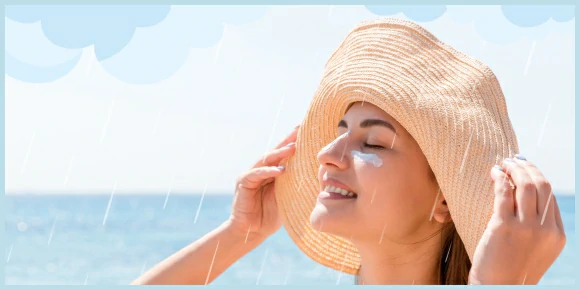Articles
Why Sunscreen is Essential During the Monsoon Season?
Introduction:
As the monsoon season arrives, most people overlook sunscreen’s importance. The cloudy skies and occasional rain showers might create a false sense of security, leading us to believe we are protected from harmful UV rays. However, this is far from the truth. Mineral or Physical Sunscreen for Women & Men remains crucial to skin care even during the monsoons. This blog post will explore why sunscreen should be an integral part of your daily routine during the rainy season.
Rain or Shine, UV Rays Persist:
Contrary to popular belief, clouds do not shield us from harmful UV rays. Even on a cloudy day, up to 80% of UV rays can penetrate through the cloud cover, causing potential harm to our skin. These UVA and UVB rays can cause long-term damage, such as premature aging, sunburn, and skin cancer. Therefore, sunscreen ENRICHED WITH 25% ZINC OXIDE will protect you from harmful rays regardless of the weather.
Increased Humidity and UV Radiation:
During the monsoon season, humidity levels tend to rise significantly. This high humidity will intensify the effects of UV radiation on the skin. The increased moisture in the air allows the UV rays to penetrate the skin more quickly, leading to a higher risk of sun damage. Applying sunscreen as a protective barrier will reduce UV rays’ absorption, safeguarding the skin from potential harm.
Intensified Reflection from Water Surfaces:
The monsoon season brings frequent rainfall, resulting in puddles and wet surfaces. These water bodies act as reflective surfaces, bouncing the sun’s rays onto our skin. This reflection can increase the intensity of UV exposure, making it essential to wear sunscreen even when it’s raining. If you enjoy outdoor activities such as walks in the rain or participating in water sports. Applying a Very water resistant up to 80 minutes sunscreen will give protection and prevent sunburns caused by UV rays.
Let’s explore some important things to remember when using sunscreen during the monsoon:
- UV radiation exposure occurs during the day, particularly between 11 am and 4 pm.
- You Should not skip the sunscreen even if you are inside the house because UVA rays penetrate through the window.
- Choose the physical or Mineral Sunscreen with zero wait time.
- Reapplication of sunscreen every 2 hours, especially when swimming, sweating or exercising.
- when Purchasing sunscreen, buy Physical or Mineral 25% ZINC OXIDE, which should have 50 SPF to protect against UVA and UV rays.
- By water-resistant sunscreen so that it doesn’t get washed off in the rain.
- Because UV rays can still penetrate through clothing, applying sunscreen to your body is crucial.
- Doing a patch test before applying it to your face is advisable to check whether it suits your skin.
Choosing the Right Sunscreen:
When selecting sunscreen for the monsoon season, there are a few key factors to consider. Look for a broad-spectrum Mineral or Physical Sunscreen that protects against UVA and UVB rays. Opt for a water-resistant formula to ensure prolonged protection, even during rainfall or water activities. Sunscreen with a minimum SPF 50+++ is recommended for everyday use. Remember to apply sunscreen generously to all exposed areas of your body, including the face, neck, arms, and legs.
Conclusion:
While the monsoon season may create an illusion of protection from harmful UV rays, the truth is that sunscreen remains an essential skincare product throughout the year. Rain or shine, the damaging effects of UV radiation persist, making sunscreen a vital defense against sunburn, premature aging, and other sun-related skin concerns. By incorporating sunscreen into your daily skincare routine during the monsoons, you can enjoy the rains while ensuring your skin’s health and longevity. So, grab that bottle of Lely’s Mineral or Physical Sunscreen, and step out confidently, knowing you’re safeguarding your skin against the monsoon sun.


